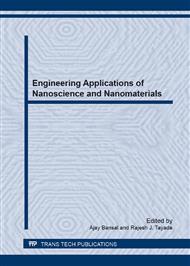[1]
J. S. Beck, J. C. Vartuli, W. J. Roth, M. E. Leonowicz, C. T. Kresge, K. D. Schmitt, C. T-W. Chu, D. H. Olson, E. W. Sheppard, S. B. McCulen, J. B. Higgins, J. L. Schlenker, A new family of mesoporous molecular sieves prepared with liquid crystal templates, J. Am. Chem. Soc. 114(1991) 10834-10843.
DOI: 10.1021/ja00053a020
Google Scholar
[2]
M. Ogawa, Formation of Novel Oriented Transparent Films of Layered Silica-Surfactant Nanocomposites, J. Am. Chem. Soc. 116(1994) 7941-7942.
DOI: 10.1021/ja00096a079
Google Scholar
[3]
G.J.A.A. Soler-Illia, P. Innocenzi, Mesoporous Hybrid Thin Films: The Physics and Chemistry Beneath, Chem. Eur. J. 12(2006) 4478-4494.
DOI: 10.1002/chem.200500801
Google Scholar
[4]
D. Zhao, J. Feng, Q. Huo, N. Melosh, G. H. Fredrickson, B. F. Chemlka, G. D. Stucky, Triblock Copolymer Syntheses of Mesoporous Silica with Periodic 50 to 300 Angstrom Pores, Science 279(1998) 548-552.
DOI: 10.1126/science.279.5350.548
Google Scholar
[5]
J. C. Vartuli, K. D. Schmitt, C. T. Kresge, W. J. Roth, M. E. Leonowicz, S. B. McCullen, S. D. Hellring, J. S. Beck, J. L. Schlenker, Effect of Surfactant/Silica Molar Ratios on the Formation of Mesoporous Molecular Sieves: Inorganic Mimicry of Surfactant Liquid-Crystal Phases and Mechanistic Implications, Chem. Mater. 6(1994) 2317-2326.
DOI: 10.1021/cm00048a018
Google Scholar
[6]
Q. Huo, R. Leon, P. M. Petroff, G. D. Stucky, Mesostructure Design with Gemini Surfactants: Supercage Formation in a Three-Dimensional Hexagonal Array, Science 268(1995) 1324-1327.
DOI: 10.1126/science.268.5215.1324
Google Scholar
[7]
Q. Huo, D.I. Margolese, G. D. Stucky, Surfactant Control of Phases in the Synthesis of Mesoporous Silica-Based Materials, Chem. Mater. 8(1996) 1147-1160.
DOI: 10.1021/cm960137h
Google Scholar
[8]
D. Grosso, F. Cagnol, G. J. A. A. Soler-Illia, E. L. Crepaldi, H. Amenitsch, A. B. Bruneau, A. Bourgeois, C. Sanchez, Fundamentals of Mesostructuring Through Evaporation-Induced Self-Assembly, Adv. Funct. Mater. 14(2004) 309-322.
DOI: 10.1002/adfm.200305036
Google Scholar
[9]
C. Sanchez, B. Lebeau, F. Chaput, J. P. Boilot, Optical properties of functional hybrid organic-inorganic nanocomposites, Adv. Mater. 15(2003) 1969-1994.
DOI: 10.1002/adma.200300389
Google Scholar
[10]
B. Dunn, J. I. Zink, Molecules in Glass: Probes, Ordered Assemblies, and Functional Materials, Acc. Chem. Res. 40(2007) 747-755.
DOI: 10.1021/ar700033b
Google Scholar
[11]
H. S. Zhou, H. Sasabe, I. Honma, Synthesis of phthalocyanine-doped silica mesostructured materials by ferrocenyl surfactant, J. Mater. Chem. 8(1998) 515-516.
DOI: 10.1039/a707884f
Google Scholar
[12]
L. Nicole, C. Boissiere, D Grosso, A Quach, C Sanchez,; Mesostructured hybrid organic–inorganic thin films. J. Mater. Chem. 15(2005) 3598-3627.
DOI: 10.1039/b506072a
Google Scholar
[13]
K. J. Edler, S.Roser, Growth and Characterisation of Mesoporous Silica Films. Int. Rev. Phys. Chem. 20(2001) 387-466.
Google Scholar
[14]
O. S. Wolfbeis, Fiber-optic chemical sensors and biosensors. Anal. Chem. 2008, 80, 4269-4283
DOI: 10.1021/ac800473b
Google Scholar
[15]
S. M. Borisov, O. S. Wolfbeis, Optical Biosensors. Chem. Rev. 2008, 108, 423-461.
Google Scholar
[16]
S. S. Chauhan, R. V. Jasra, A. L. Sharma, Dye immobilized mesoporous silica thin film as optical pH sensor. Int. J. Nanosci, 11(2012) 1240001-1-1240001-5.
DOI: 10.1142/s0219581x12400017
Google Scholar
[17]
B. J. Melde, B. J. Johnson, P. T. Charles, Mesoporous Silicate Materials in Sensing. Sensor 8(2008) 5202-5228.
DOI: 10.3390/s8085202
Google Scholar
[18]
S. S. Chauhan, R. V. Jasra, A. L. Sharma, Phenol Red Dye Functionalized Nanostructured Silica Films as Optical Filters and pH Sensors, Ind. Eng. Chem. Res. 51(2012) 10381-10389.
DOI: 10.1021/ie201701t
Google Scholar
[19]
R.W. Sabnis, Handbook of Acid-Base Indicators, CRC Press, Boca Raton, 2008.
Google Scholar
[20]
K. H. S. Kung, K. F. Hayes, Fourier transform infrared spectroscopic study of the adsorption of cetyltrimethylammonium bromide and cetylpyridinium chloride on silica, Langmuir 9(1993) 263-267.
DOI: 10.1021/la00025a050
Google Scholar
[21]
D.Y. Nadargi, J. L. Gurav, N. E. Hawi, A. V. Rao, M. J. Koebel, Synthesis and characterization of transparent hydrophobic silica thin films by single step sol–gel process and dip coating, J. Alloys Comp. 496(2010) 436–441.
DOI: 10.1016/j.jallcom.2010.01.157
Google Scholar
[22]
K. Y. Jung, S. B. Park, Enhanced photoactivity of silica-embedded titania particles prepared by sol–gel process for the decomposition of trichloroethylene, Appl. Catal. B Environ. 25(2000) 249-256.
DOI: 10.1016/s0926-3373(99)00134-4
Google Scholar
[23]
G. Socrates, Infrared Characteristic Group Frequencies, John Wiley & Sons, 1980.
Google Scholar
[24]
Y. Lu, R. Ganguli, C. A. Drewien, M. T. Anderson, C. J. Brinker, W. Gong, Y. Guo, H. Soyez, B. Dunn, M. H. Huang, J. I. Zink, Continuous Formation of Supported Cubic and Hexagonal Mesoporous Films by Sol−Gel Dip-Coating. Nature 389(1997) 364−368.
DOI: 10.1038/38699
Google Scholar
[25]
H. Yang, N. Coombs, I. Sokolov, G. A. Ozin, Free-standing and oriented mesoporous silica films grown at the air–water interface, Nature 381(1996) 589-592.
DOI: 10.1038/381589a0
Google Scholar
[26]
C. Rottman, G. Grader, Y. D. Hazan, S. Melchior, D. Avnir, Surfactant-induced modification of dopants reactivity in sol−gel matrixes, J. Am. Chem. Soc., 121(1999) 8533-8543.
DOI: 10.1021/ja991269p
Google Scholar
[27]
C. Rottman, M. Ottolenghi, R. Zusman, O. Lev, M. Smith, G. Gong, M. L. Kagan, D. Avnir, Doped sol-gel glasses as pH sensors, Mater. Lett. 13(1992) 293-298.
DOI: 10.1016/0167-577x(92)90055-o
Google Scholar
[28]
A. Lobnick, O. S. Wolfbeis, Probing the Polarity of Sol-Gels and Ormosils via the Absorption of Nile Red, J. Sol-Gel Sci. Technol. 20(2001) 303-311.
Google Scholar
[29]
E. M. Moreno, D. Levy, Role of the comonomer glymo in ormosils as reflected by nile red spectroscopy, Chem. Mater. 12(2000) 2334-2340.
DOI: 10.1021/cm001048e
Google Scholar
[30]
J. D. Ingle, S. R. Crouch, Spectrochemical Analysis; Prentice Hall, New Jersey, 1988.
Google Scholar
[31]
E. Wang, C. K. Fan, V. Kwan, T. Chin, C. Wong, A. Bocarsly, Fast and long term optical sensors for ph based on sol-gels, Anal. Chim. Acta 495(2003) 45–50.
DOI: 10.1016/s0003-2670(03)00904-8
Google Scholar
[32]
R. Makote, M. M. Collinson, Organically modified silicate films for stable pH sensors, Anal. Chim. Acta 394(1999) 195-200.
DOI: 10.1016/s0003-2670(99)00305-0
Google Scholar
[33]
S. S. Chauhan, Study of Optical Sensor Based on Chemically Modified Surfaces, Ph. D. Thesis, 2011.
Google Scholar


